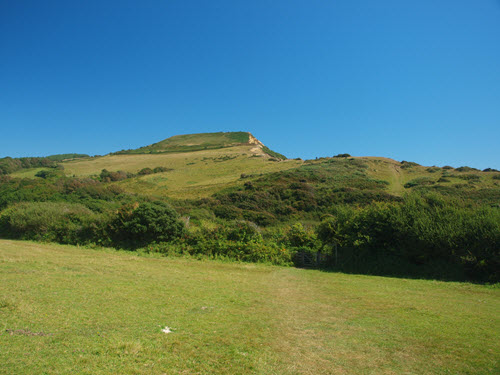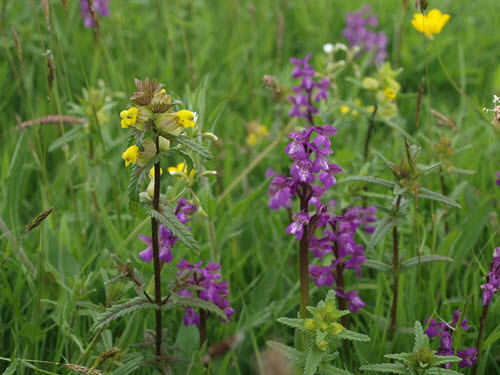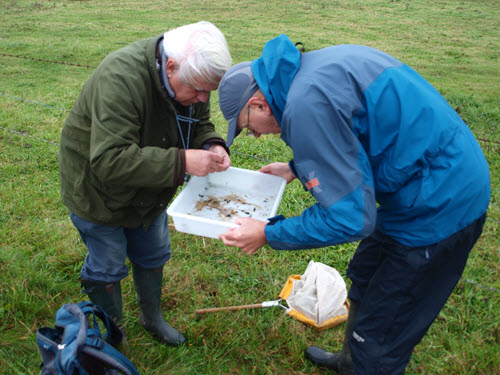Using a wildlife inventory to inform a new management plan.
The Golden Cap estate is found on Dorset’s Jurassic Coast between Eype and Lyme Regis. The estate has gradually grown from the initial acquisition of Westhay Farm in 1961 to around 170 mostly small fields, lined by hedges, lowland heath, 11 woods and plantations, ponds, small rivers and maritime soft rock cliffs of national importance. The estate has the largest area at 198 ha of lowland meadow priority habitat in the National Trust’s England and Wales estates.

Over the years, a number of surveys of the soft cliffs have revealed species such as the cliff tiger beetle Cicindella germanica and slender centaury Centaurium tenuifolium, the latter only known in Britain from the cliffs below Golden Cap. One entomologist commented that he had never identified three RDB1 insects in one survey anywhere else. Even today, our volunteer coleopterist is finding new nationally notable species on most visits. Recently Bryan Edwards reported on five near threatened lichens found on the cliffs, rarely found in Britain.
The lowland meadows, especially round Westhay Farm are farmed for nature supporting an estimated over 100,000 green-winged orchid Anacamptis morio and smaller numbers, but in more meadows, autumn lady’s-tresses Spiranthes spiralis. There are many wet flushes having a range of plants IUCN rated near threatened or vulnerable, such as Lousewort Pedicularis sylvatica. Other fields are very intensively farmed to produce grass and if we are to achieve the National Trust’s plan “to nurse the natural environment back to health and reverse the alarming decline in wildlife”, there will need to be changes to farming practice.

The fields and hedges provide habitat for 12 S41 UK BAP Priority species birds such as song thrush, often seen in the damp meadows and on woodland edges. The scrub areas of lowland heath are home to linnet, rare migrant grasshopper warbler, whilst migrating flocks of yellow wagtail follow the cattle in late August and early September.
The National Trust last collated the state of nature in a Biological Conservation Assessment in 1995. This report made various recommendations to fill gaps in our knowledge. Since 2005, John Newbould (NBN Honorary Member and a National Trust Volunteer Specialist) has been steadily working to fill some of the gaps, together with a small team of volunteers.
One of the early surveying tasks was to undertake hedgerow surveys across the estate, which identified numerous veteran, ash, oak and maple coppice stools, often marking significant turning points in old parish boundaries. We have nearly managed to survey all the 170 meadows at least once with reports written and records to data centres. One current project is to use Ananbat Acrobat heterodyne bat recorders initially to monitor the estate’s farm buildings for bats. Another volunteer, Colin Marsh, leads this project, confirming the presence of common pipistrelle, soprano pipistrelle, lesser horseshoe and serotine. In the case of lesser horseshoe bat, our data will bring up to date, records on the NBN Gateway previously recorded in the date range 1980 – 1999 and 2000 – 2010. We will be having the traces examined by an expert to verify all the records at the end of the season.

Surveying the invertebrates is our most difficult task with just a small team undertaking specific groups. Although very time consuming, the work of the Natural History Museum updating the UK Species Inventory together with the latest conservation status available on the NBN Gateway is invaluable in sorting out the rare and scarce species. Taking just one species, fleabane tortoise beetle Cassida murraea appears to have declined on the estate since 1995. Is this a trend seen elsewhere? Using the NBN Gateway with date classes as above, over half the squares have records pre 2000.
There are gaps in our specialists. We have nobody looking at spiders and harvestmen or mollusca for example. We welcome visiting naturalists and recording schemes to contribute. Maps, information about parking and other facilities will be provided. We also welcome any data your have, which has not been given to a data centre or recording scheme. To contact us please email westdorset@nationaltrust.org.uk
Written by John Newbould, National Trust Volunteer Specialist and NBN Honorary Member.
